| dc.contributor.author | Senol Balaban, Meltem | |
| dc.contributor.author | Dogulu, Canay | |
| dc.contributor.author | Akdede, Nil | |
| dc.contributor.author | Akoglu, Haldun | |
| dc.contributor.author | Karakayali, Onur | |
| dc.contributor.author | Yilmaz, Sarper | |
| dc.contributor.author | Yilmaz, Serkan | |
| dc.contributor.author | Ajobiewe, Tolulope | |
| dc.contributor.author | Guzel, Selin | |
| dc.contributor.author | Ikizer, Gozde | |
| dc.contributor.author | Akin, Muge | |
| dc.contributor.author | Unal, Yesim | |
| dc.contributor.author | Karanci, Ayse Nuray | |
| dc.date.accessioned | 2024-03-04T13:09:53Z | |
| dc.date.available | 2024-03-04T13:09:53Z | |
| dc.date.issued | 2024 | en_US |
| dc.identifier.issn | 1570-761X | |
| dc.identifier.issn | 1573-1456 | |
| dc.identifier.other | WOS:001157134500001 | |
| dc.identifier.uri | https://doi.org/10.1007/s10518-024-01867-3 | |
| dc.identifier.uri | https://hdl.handle.net/20.500.12573/1980 | |
| dc.description.abstract | Türkiye has a long history of devastating earthquakes, and on February 6, 2023, the region
experienced two major earthquakes with magnitudes of 7.7 and 7.6, striking Pazarcık and
Elbistan, Kahramanmaraş, respectively, on the East Anatolian Fault Zone. These earthquakes resulted in signifcant loss of life and property, impacting multiple cities across 11
cities, and leaving a lasting impact on the country. The 2023 Kahramanmaraş Earthquakes
rank among the deadliest and most damaging earthquakes in Türkiye, alongside the historical signifcance of the 1939 Erzincan Earthquake and the 1999 Marmara Earthquake.
Despite reforms following the 1999 Marmara Earthquake in disaster policy and preparedness, the scale of damage from the February 6 earthquakes has been shocking, necessitating further insights and lessons for future earthquake management. This paper presents the
outcomes of immediate response eforts organized after the 2023 Kahramanmaraş earthquakes to elucidate emergency response activities and their impacts on communities, considering the substantial size and severity of the damages. The study focuses on evaluating
the emergency response provided within the frst 24 h, 3 days, and 2 weeks after the earthquakes, aiming to promptly identify the nature and efectiveness of these responses, as well
as the conditions that hindered their efcacy. By shedding light on the specifc experiences
and challenges faced during these crucial timeframes, the research aims to ofer valuable
insights and lessons learned. These fndings contribute to improved preparedness strategies
and more efcient emergency response measures needed in responding to future disaster
scenarios. Ultimately, this study provides a useful resource for all stakeholders involved in
emergency response and disaster management, ofering valuable guidance to enhance resilience and preparedness in the face of seismic hazards. | en_US |
| dc.language.iso | eng | en_US |
| dc.publisher | SPRINGER | en_US |
| dc.relation.isversionof | 10.1007/s10518-024-01867-3 | en_US |
| dc.rights | info:eu-repo/semantics/openAccess | en_US |
| dc.subject | Emergency response | en_US |
| dc.subject | Relief | en_US |
| dc.subject | Shelter | en_US |
| dc.subject | Health services | en_US |
| dc.subject | Community impact | en_US |
| dc.title | Emergency response, and community impact after February 6, 2023 Kahramanmaraş Pazarcık and Elbistan Earthquakes: reconnaissance findings and observations on affected region in Türkiye | en_US |
| dc.type | article | en_US |
| dc.contributor.department | AGÜ, Mühendislik Fakültesi, İnşaat Mühendisliği Bölümü | en_US |
| dc.contributor.authorID | 0000-0001-8873-5287 | en_US |
| dc.contributor.institutionauthor | Akın, Müge | |
| dc.identifier.startpage | 1 | en_US |
| dc.identifier.endpage | 30 | en_US |
| dc.relation.journal | BULLETIN OF EARTHQUAKE ENGINEERING | en_US |
| dc.relation.publicationcategory | Makale - Uluslararası Hakemli Dergi - Kurum Öğretim Elemanı | en_US |


















